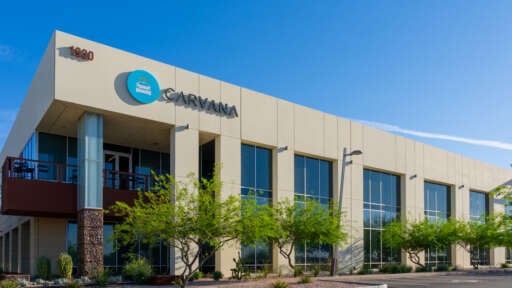
I have just had an epiphany. In the nineteenth century, the British economy grew explosively, inflation was low or non-existent, we ruled a quarter of the world and nearly 500m people, mostly much better than they had ever ruled themselves, most of the great inventors and engineers were British, our institutions became the model for countless countries, we pretty much invented modern sport and we were the kings of all we surveyed. A British passport was like an entry ticket to Heaven.
And then what did we do? We gave the vote to women, and everything started to fall apart. Women are wonderful and look great in miniskirts and high heels, but as arbiters of the nation’s destiny, no way. Suddenly, women and children, the first to get off a boat in an emergency, were the captains of the ship. People ruled by their hearts and their hormones were expected to make decisions with the icy coolness required of our leaders. It was a total car crash, and look at the results.
The elite are confused because women who leave Oxbridge with double firsts are as smart as the men, and Marie Curie invented radiotherapy, but as Georgette Heyer put it so well, most women are pretty widgeons. They are wonderful at looking after men; every man should have one, and, when they arrive, they are great with children, but they need a man to take care of them and do the heavy lifting. And that includes looking after the national interest and taking the big decisions.
I don’t suppose we can turn the clock back. Feminism has taken too strong a hold, but what a wonderful world it would be if we could. Left to themselves, what do women talk about? They talk about men, they talk about sex, they talk about families, and the latest beauty treatments and the terrible things their one-time best friend has done to them. Do they talk about anything serious? Very rarely.
As Rex Harrison put it so pithily in My Fair Lady – ‘Why can’t a woman be more like a man. Men are so honest, so thoroughly square; Eternally noble, historically fair.’ Exactly!
I once asked a female friend of mine if she minded being a woman, always under the thumb of some guy. She said no, absolutely not, she loved being female, doing all the girly-whirly things and had no desire to be a man. When you see girls together, they are always chatting away, having a great time, then they go on a date with some guy and spend half the evening staring into space. It is the ladies who have won the gender battle if only they had the sense to realise it.
The AI bubble theory has now popped up in The Sunday Times in a two-page spread. I don’t think anyone can spot a bubble until afterwards, and as yet, there is no hard evidence that we are in a bubble. Latest results from companies like Nvidia and Palantir were incredible. OpenAI can’t put in infrastructure quickly enough, and Anthropic recently announced that its annualised turnover had grown from $1 billion a year to $7 billion in less than a year. The usual name for what is happening is not bubble, but boom.
Imagine that planet Earth was attacked by an alien civilisation that was not so technologically advanced that we were immediately wiped out. Military spending would go through the roof. Would this be a bubble? I don’t think so. Some booms run and run.
Worst case, it is a bubble like 2000. Shares plummeted, and many insubstantial technology shares disappeared without a trace, but the ones with something real happening, like Amazon, didn’t. I was there in 2000, I was there in the early 1970s when Australian mining shares took off in the greatest bubble I have ever seen; I missed the railway boom in the 1840s, which ended in tears.
But let us think about the big picture. Was it a bubble when humans started growing crops, domesticating animals and living in settlements, or was it a massive change? Was the Renaissance a bubble or the Industrial Revolution? Sometimes big stuff happens. We are moving into an era when machines can think, can draw on computers with almost limitless processing power and millennia of data to process. I would suggest this is a big change, and it is being short-sold by Mike Burry. Brave man!
This is not to say that manic Mr Market can’t veer from euphoria to depression. He can, he does it all the time, but there is no hard evidence that shares like Nvidia, Palantir, Broadcom, Credo Technology, CrowdStrike, Vertiv and many others are in a bubble. You might as well say any company that is growing fast and attracting attention from investors is in a bubble.
What are momentum investors supposed to do? Invest in shares that don’t have momentum.
Listen to Eric Schmidt, the former CEO of Google.
The arrival of non-human intelligence is a very big deal, says former Google CEO and chairman Eric Schmidt. In a wide-ranging interview with technologist Bilawal Sidhu, Schmidt makes the case that AI is wildly underhyped, as near-constant breakthroughs give rise to systems capable of doing even the most complex tasks on their own. He explores the staggering opportunities, sobering challenges and urgent risks of AI, showing why everyone will need to engage with this technology in order to remain relevant.
Erc Schmidt, Ted Talk, April 2025
The Establishment in 1955 dismissed Elvis Presley as a bubble. Turns out he ushered in a new era of popular music, in my opinion, was a God who briefly walked the earth, and has been described by opera singer Kiri Te Kanawa as having the greatest voice she ever heard. For a time, the only people who realised how amazing Elvis was were a fairground huckster calling himself Colonel Tom Parker, every teenage girl in America, and my 10-year-old friends at prep school, who played Elvis records non-stop. The great, the good and the wise had no idea what was happening.
Schmidt has suggested that the impact of AI is going to usher in an era of explosive productivity growth. In the film 2001: A Space Odyssey, a machine called Hal ran the ship. The humans had little to do. In H.G.Wells’ book, The Time Machine, there are two types of people, the gentle Eloi and the rough underground living Morlocks, who did all the work and periodically hunted the Eloi for food. This sounds alarmingly like the kind of world we could be headed for. The Morlocks will be robots or machines of some kind, and we will be the indolent Eloi. Hopefully, they will not need to eat us.
Another possibility is that the imagination and creativity of humans, allied to limitless knowledge and computing power, will usher in an age of almost inconceivable wonders. This hardly seems the background for shares to collapse. I was intrigued to learn that the language of AI is English. We didn’t build the Empire for nothing. How incredible if Star Wars is right and one day the language of the Galaxy will be English.
I have been saying in recent issues that something extraordinary is happening in the world of biotech, with shares blasting higher like geysers all over the place. Below is another example.
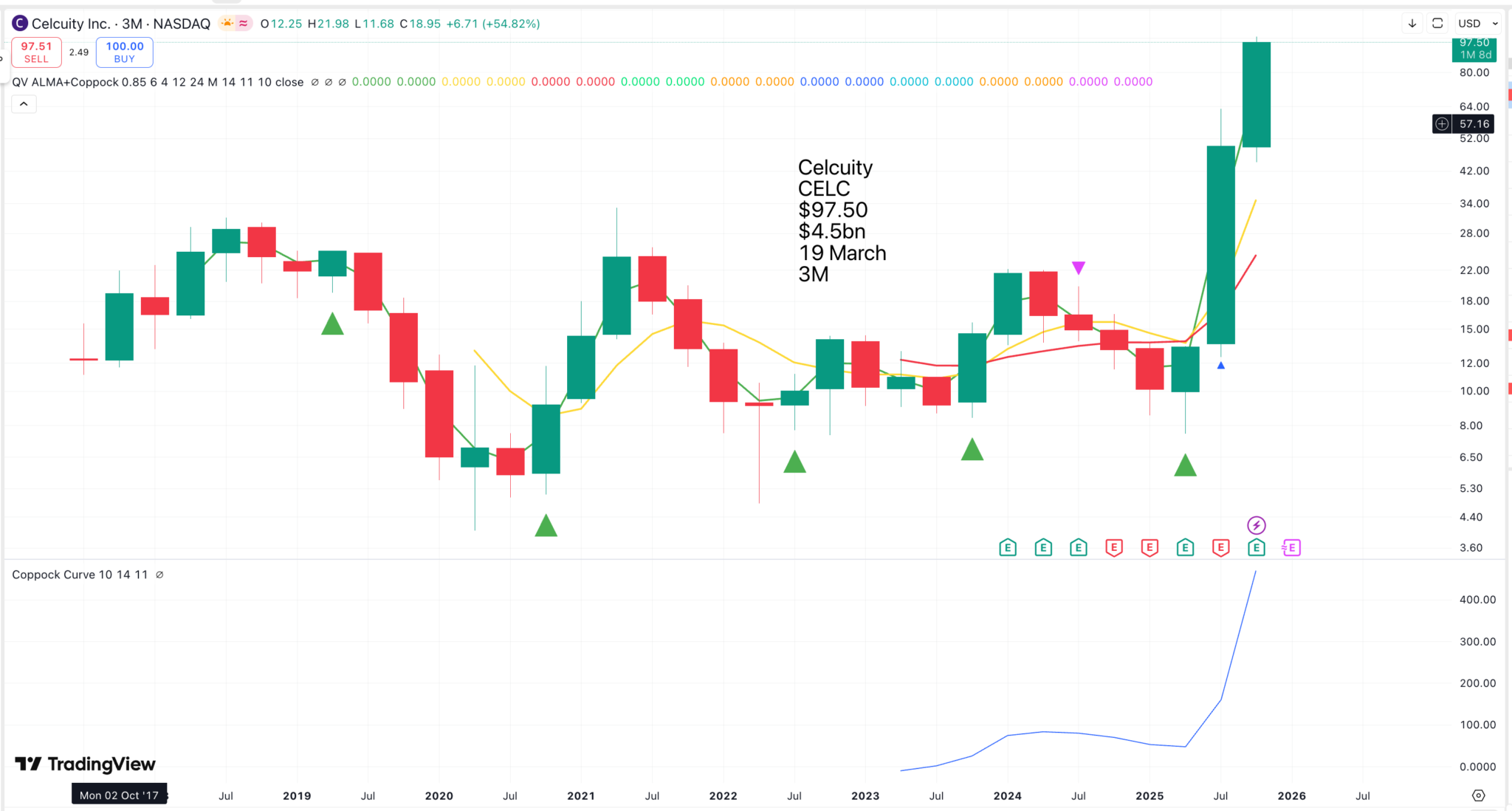
In the past, I would have used Celcuity’s description of what they do, even though to a layman it is total gobbledygook, but now I can ask AI.
Celcuity is a clinical-stage biotechnology company that develops targeted cancer therapies by focusing on the PI3K/AKT/mTOR (PAM) signaling pathway. Its main activities include advancing its lead drug candidate, gedatolisib, and using its companion diagnostic platform, CELsignia, to identify which patients might benefit from its therapies.
Key activities
Developing gedatolisib: Celcuity is developing gedatolisib, a drug designed to inhibit multiple components of the PAM pathway at the same time. This approach is intended to be more effective than drugs that target only one part of the pathway, potentially helping to overcome drug resistance.
Treating solid tumors: The company is advancing gedatolisib for multiple solid tumor types, including breast, prostate, and gynecological cancers.
Using the CELsignia platform: This is a companion diagnostic tool used to analyze live tumor cells to identify specific signaling pathways that are abnormal and driving tumor growth. This helps determine if a patient’s tumor is likely to respond to targeted therapies like gedatolisib.
Conducting clinical trials: Celcuity is conducting clinical trials to test the efficacy of gedatolisib, including a Phase 3 trial for advanced breast cancer.
Partnering with other companies: The company also partners with other pharmaceutical companies to evaluate the efficacy of targeted therapies in cancer patients.
AI overview
I asked AI what the PAM pathway is and got this response.

So that’s all clear. Fortunately, it came with an explanation.
The PAM pathway is a signaling pathway that stands for Phosphatidylinositol 3-kinase (PI3K)/AkT/mammalian target of rapamycin (mTOR). It is a crucial, highly conserved network in eukaryotic cells that regulates cell survival, growth, proliferation, and metabolism. The PAM pathway is frequently dysregulated in cancer, where its hyperactivation can lead to tumor growth and drug resistance.
How it works
Initiation: The pathway is triggered by external signals, such as growth factors binding to their receptors.
PI3K: Phosphoinositide 3-kinase (PI3K) is a key enzyme in this cascade, receiving the signal and initiating a series of downstream events.
AKT: The signal is then passed to the protein kinase B (AKT).
mTOR: AKT then activates the mammalian target of rapamycin (mTOR) complex.
Downstream effects: This chain of activation ultimately leads to a wide range of cellular processes, including protein synthesis, cell growth, and survival.
Role in cancer
Frequent dysregulation: The PAM pathway is the most frequently activated signaling pathway in human cancers, found in about 50% of tumors.
Cancer promotion: When overactive, this pathway can drive cancer by promoting uncontrolled cell proliferation, preventing apoptosis (cell death), and enhancing cell migration and invasion.
Therapy resistance: Hyperactivation of the PAM pathway can also contribute to a cancer’s resistance to various treatments.
Therapeutic implications
Targeted therapy: Because of its role in cancer, components of the PAM pathway (PI3K, AKT, and mTOR) are major targets for drug development.
Inhibitors: Numerous inhibitors that target PI3K, AKT, or mTOR are in clinical trials or have been approved, often used in combination therapies to overcome resistance.
AI overview
When you read this stuff, you realise why cancer is such an intractable disease to treat, but also the amazing progress being made. It seems a classic area for everything that is happening with AI. Drug discovery and testing seem to be a lot about crunching numbers, just what computers are good at. It makes Celcuity sound exciting. Any breakthroughs could have a huge impact.
They are playing for massive stakes. Note that SOC below stands for Standard of Care.
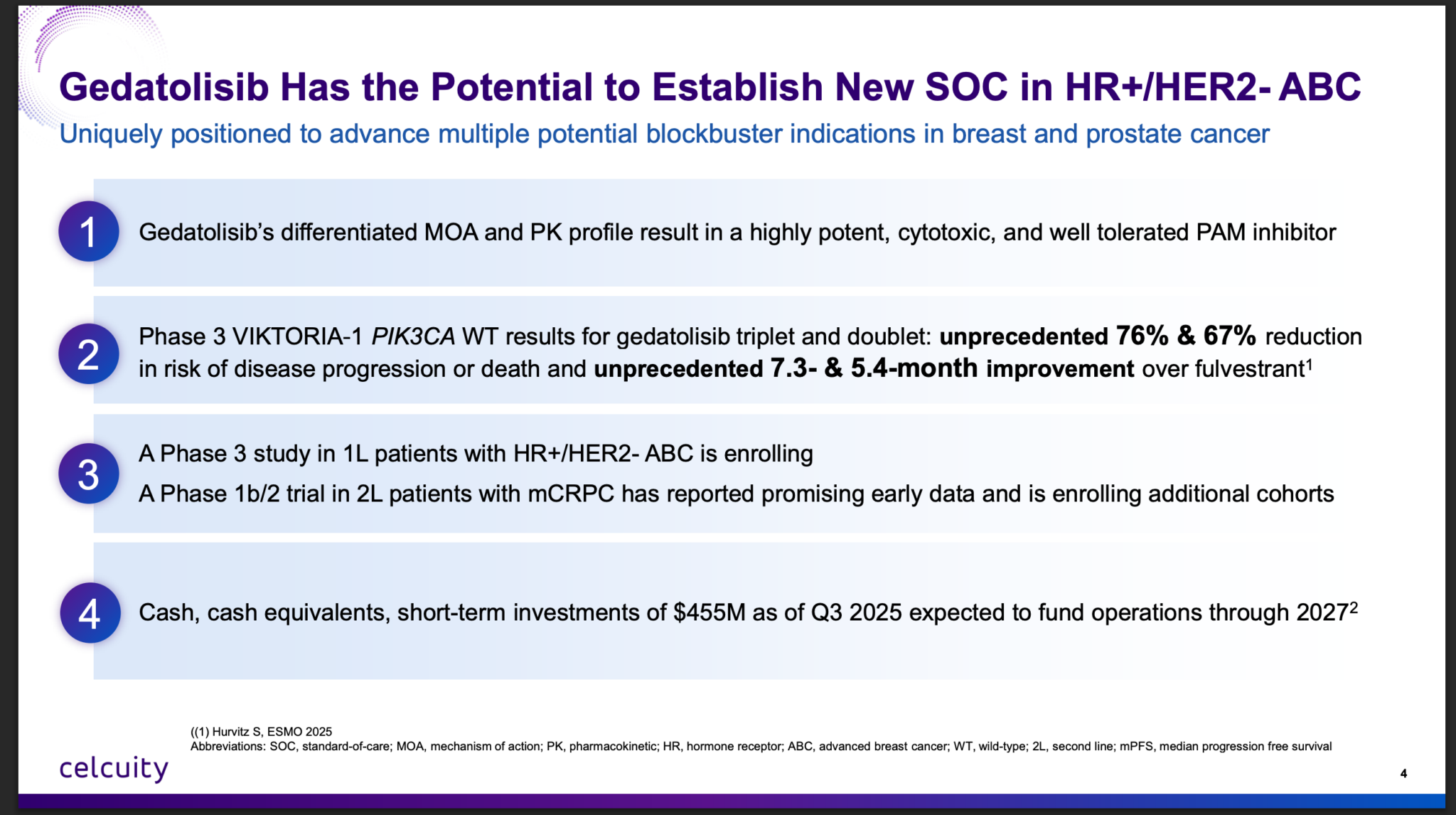
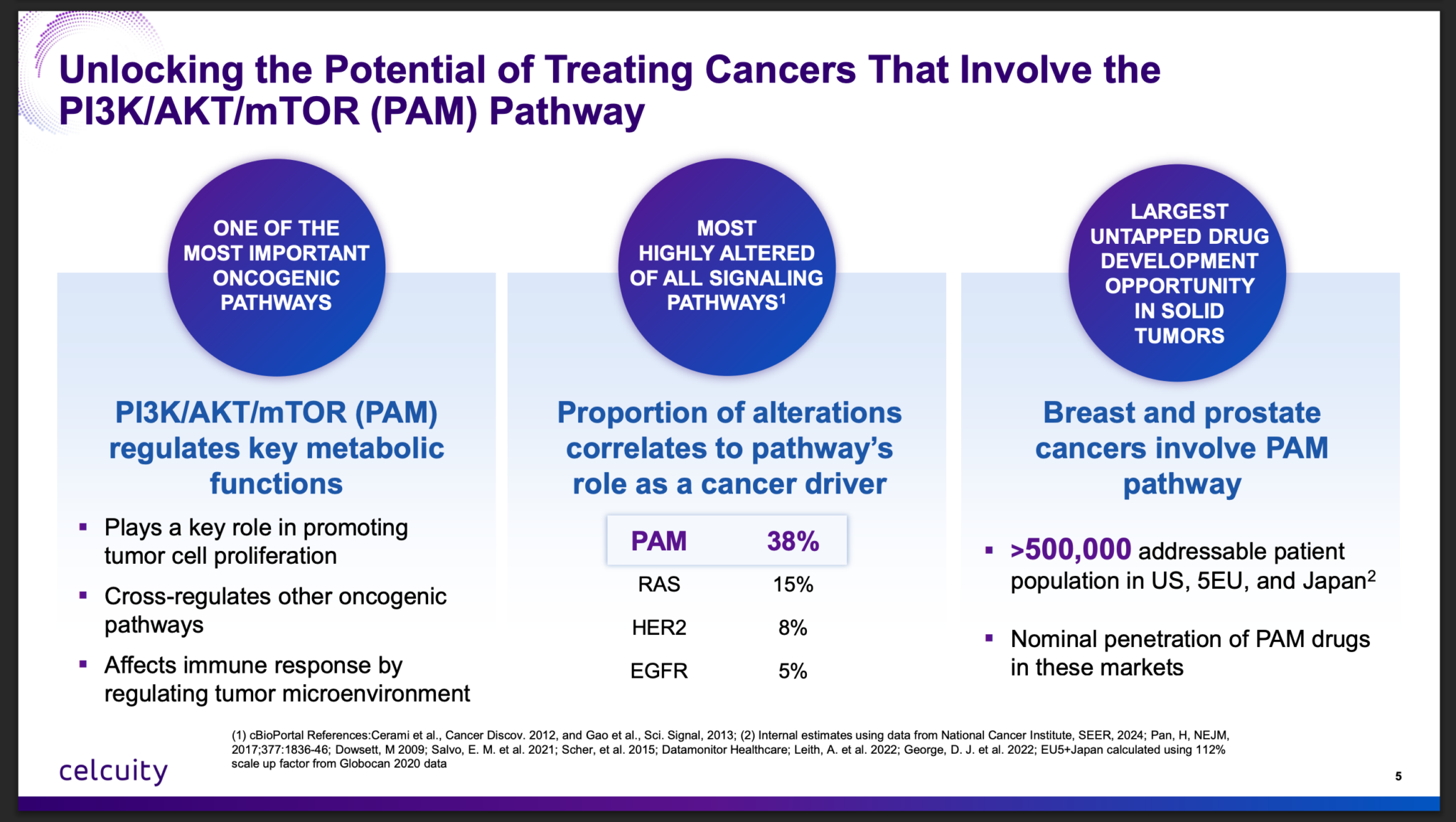
The opportunity seems so massive that it is hard to believe that Celcuity can compete with Big Pharma in this therapeutic area. The Celcuity presentation from which the above slides are taken is the most technically complex I have ever seen. No layman could make head nor tail of it. You almost wonder to whom it is addressed. I suspect most doctors would be baffled.
Curiously enough, the CEO and co-founder, Brian Sullivan, like Argenx CEO, Tim Van Hauwermeiren, does not have a pharmaceutical background and graduated magna cum laude with distinction from Harvard. His degree was in economics. The rest of the team are serious biopharma nerds.
In its latest quarterly results, Celcuity had this to say.
The most consequential milestone of the quarter for Celcuity was, of course, the release of positive data from the PIK3CA wild-type cohort of the VIKTORIA-1 trial. And we’ve discussed previously the historic nature of the results and the new milestones they achieved in HR-positive, HER2-negative advanced breast cancer.
Brian Sullivan, CEO, Celcuity, Q3 2025, 12 November 2025
I asked AI about this trial.
The VIKTORIA-1 trial is a Celcuity-sponsored Phase 3 clinical trial evaluating the investigational drug gedatolisib for advanced or metastatic HR+/HER2- breast cancer that has progressed after previous CDK4/6 inhibitor therapy. The trial tests gedatolisib in combination with fulvestrant (with or without palbociclib) against standard-of-care options and has fully enrolled both its PIK3CA wild-type and mutant cohorts. Recent results from the PIK3CA wild-type cohort showed statistically significant improvements in progression-free survival, and Celcuity plans to submit a new drug application to the FDA in late 2025.
Trial details
Sponsor: Celcuity
Phase: Phase 3
Purpose: To evaluate the efficacy and safety of gedatolisib for advanced HR+/HER2- breast cancer that has progressed after a CDK4/6 inhibitor and aromatase inhibitor.
Patient population: Patients with locally advanced or metastatic HR+/HER2- breast cancer who have already been treated with a CDK4/6 inhibitor plus an aromatase inhibitor.
Treatment arms: The trial compares different regimens:
Gedatolisib plus palbociclib and fulvestrant
Gedatolisib plus fulvestrant only
Standard-of-care therapy based on tumor biology
Investigational drug: Gedatolisib, which is an investigational multi-target inhibitor of the PI3K/mTOR pathway.
Trial status and results
Enrollment: The trial is fully enrolled for both its PIK3CA wild-type and mutant cohorts.
Results: Topline data from the PIK3CA wild-type cohort, presented in late 2025, showed a statistically significant and clinically meaningful improvement in progression-free survival compared to standard-of-care.
Next steps: Celcuity plans to submit a New Drug Application (NDA) to the U.S. Food and Drug Administration (FDA) in the fourth quarter of 2025 based on these results. Topline data for the PIK3CA mutant cohort is expected later.
AI overview
As a result of this progress, the excitement is ramping up at Celcuity.
Now as we near what we hope is an FDA approval for gedatolisib in 2026, our efforts to prepare for the potential launch of gedatolisib have ramped up per our strategic launch plan. Foundational to these efforts was the additional cash we raised and the enhanced financial flexibility, our $500 million term loan facility provides us. We began laying the groundwork for a potential gedatolisib launch 18 months ago, and we’ve since made significant progress building the organization and internal systems required to operate as a commercial stage company. Now as planned, once the VIKTORIA-1 wild-type data was in hand, our commercial launch preparation efforts significantly accelerated. Except for the field sales force, we’ve mostly completed hiring of the individuals needed to execute the launch, and we’re very fortunate to have attracted an incredibly talented group of individuals who have a strong track record of successfully launching novel oncology therapeutics.
Our sales management and customer operations groups have defined our regional and sales territories and our go-to-market objectives for each one. The medical science liaison and KOL* engagement teams have done a great job of exchanging scientific information with key opinion leaders and community practice leaders and obtaining important insights and feedback from them.
*KOL engagement teams are groups that develop and manage relationships with key opinion leaders (KOLs), who are external experts and thought leaders in a specific field, such as healthcare. Their goal is to gather valuable insights, provide scientific exchange, and strengthen a company’s position in areas like product development, market access, and commercial strategy. These teams are critical for organizations to get expert input, drive innovation, and build long-term, mutually beneficial relationships with their stakeholders.
Now key efforts today include extensive outreach across the country to the payers and population health decision-makers in various treatment settings, including health systems, integrated delivery networks and community oncology practices that will play a key role in providing oncologists access to gedatolisib for their patients. We’ve made strong progress engaging with these decision-makers, and we’re very pleased with the feedback and enthusiastic response these efforts have yielded. We’re also very encouraged by the results of research we have fielded to gauge the willingness of community and academic oncologists to prescribe gedatolisib should it get approved. And these results make us optimistic about the possibility of establishing gedatolisib as the new standard of care in the second-line setting for HR-positive, HER2-negative advanced breast cancer in the wild-type patient population.
Now in light of this feedback, we believe obtaining majority market share in this setting appears not only achievable, but potentially too conservative. Based on analysis of published epidemiological data, we estimate there are 37,000 patients in the U.S. with HR-positive, HER2-negative advanced breast cancer who’ve progressed after treatment with a CDK4/6 inhibitor. Using internal duration of treatment estimates and pricing assumptions consistent with currently available novel therapeutics for breast cancer, we estimate the total addressable market for gedatolisib in the second-line setting is $5 billion to $6 billion. And given the significant penetration our research is suggesting we can achieve, we believe it’s reasonable to estimate that a second-line wild-type indication or second-line indication in general for gedatolisib can potentially generate peak revenues of $2.5 billion to $3 billion.
The progress we’ve made to date is encouraging and exciting. We look forward to providing you updates over the next few quarters. We believe the resources we’ve raised will enable us to advance multiple potential blockbuster indications in breast and prostate cancer while also aggressively preparing for and potentially launching gedatolisib commercially should we receive FDA approval.
Brian Sullivan, CEO, Celcuity, Q3 2025, 12 November 2025
The prospects for Celcuity to emerge as a significant biopharma company look excellent.
We’ve discussed in other calls or at least we’ve mentioned that we expect to commercialize in the U.S. and as I discussed on the call, and then find a partner or partners to commercialize the drug ex U.S. And we are holding off finalizing or really moving forward with intense discussions on that until we have our mutant data available and until we’ve submitted what we hope is an sNDA [supplemental new drug application] for the mutant population. And coincident with the submission of the sNDA for the mutant population, if all goes according to plan, we would soon after expect to file an MAA to the European medical authorities that would comprise both mutant and wild-type patient data.
Additionally, we’ve also been working with the Japanese health authority to identify their requirements for a submission. We think we’re aligned with them on an approach that makes sense to us. And so, we’re moving forward on a regulatory path that will allow us to stay on track with as rapid commercialization as possible, even without the — rather a marketing partner. And we would expect to start engaging those discussions once, I would say, the middle of next year once our data was available and the regulatory submissions were on their way.
Brian Sullivan, CEO, Celcuity, Q3 2025, 12 November 2025
It all clearly feels very real to them.
We have several sites for manufacturing, and we have an approach that we think allows us to have flexibility in how we manufacture, where we manufacture the drug. We haven’t really announced where we’re manufacturing the drug. But based on our kind of inventory approach and also our approach to finding second sources, we’re basically taking the steps necessary to make sure our supply chain is as bulletproof as you can make it.
Brian Sullivan, CEO, Celcuity, Q3 2025, 12 November 2025
Celcuity is valued at $4.6bn, yet there are hints in the earnings transcript that its first drug could have revenue potential of $2.5bn -$3bn, most of which would be profit. The shares look cheap, and the chart looks fantastic. Beyond $2.5bn, the company talks about an addressable market of 500,000 patients for its breast and prostate cancer drugs, which would generate way more than $2.5bn in income.
Its core activity sounds promising.

I asked AI if it thought Celcuity was a good investment.
Investing in Celcuity (CELC) is considered high risk but has a “Strong Buy” consensus rating from Wall Street analysts, driven by promising clinical trial data for its cancer drug, gedatolisib. The company is in the clinical stage and is not yet profitable, meaning investment potential is tied to the successful development and commercialization of its drug candidates.
Analyst Ratings and Price Targets
Consensus Rating: A “Strong Buy” based on recommendations from multiple brokerage firms (e.g., Stifel, Leerink Partners, Needham).
Average Price Target: The average 12-month price target is approximately $103.56, representing a potential increase from the last closing price of around $97.50 (as of November 21, 2025). Forecasts range from a low of $94.00 to a high of $115.00.
Recent Momentum: The stock has shown strong performance, soaring over 500% in the past year, reaching new highs on positive news.
Key Investment Considerations
Potential Positives
Promising Drug Candidate: The lead drug candidate, gedatolisib, has shown encouraging early results in clinical trials for prostate and advanced breast cancer, particularly in a segment where rival drugs have struggled.
Favorable Market Position: Analysts believe gedatolisib is positioned to be a leading treatment, potentially capturing a large market share.
Strong Financial Position for R&D: Celcuity maintains a significant cash position ($455 million as of Q3 2025) to fund operations and clinical trials, projected to last through 2027.
Positive Insider Sentiment: Insiders have been making high-impact open-market purchases, signaling confidence in the company’s future.
Key Risks and Challenges
Lack of Current Revenue/Profitability: As a clinical-stage biotech company, Celcuity has no product sales and operates at a net loss, investing heavily in research and development.
High Volatility and Risk: The stock is considered high risk and volatile, with significant price movements driven by clinical trial results and market expectations.
Valuation Concerns: Some metrics, such as a high price-to-book (P/B) ratio, suggest the stock may be overvalued relative to current assets, though a discounted cash flow (DCF) analysis suggests potential undervaluation based on future cash flow expectations.
Regulatory Hurdles: The company is dependent on a successful New Drug Application (NDA) submission to the FDA, a process expected to be completed in Q4 2025.
Conclusion
Celcuity is a growth-oriented, high-risk investment. Its potential lies in the success of its experimental cancer treatment, which has generated significant analyst optimism and stock performance. Investors should be aware of the inherent volatility and the fact that the company is not yet profitable. It may be suitable for investors with a high-risk tolerance who believe in the long-term potential of its drug pipeline.
AI overview
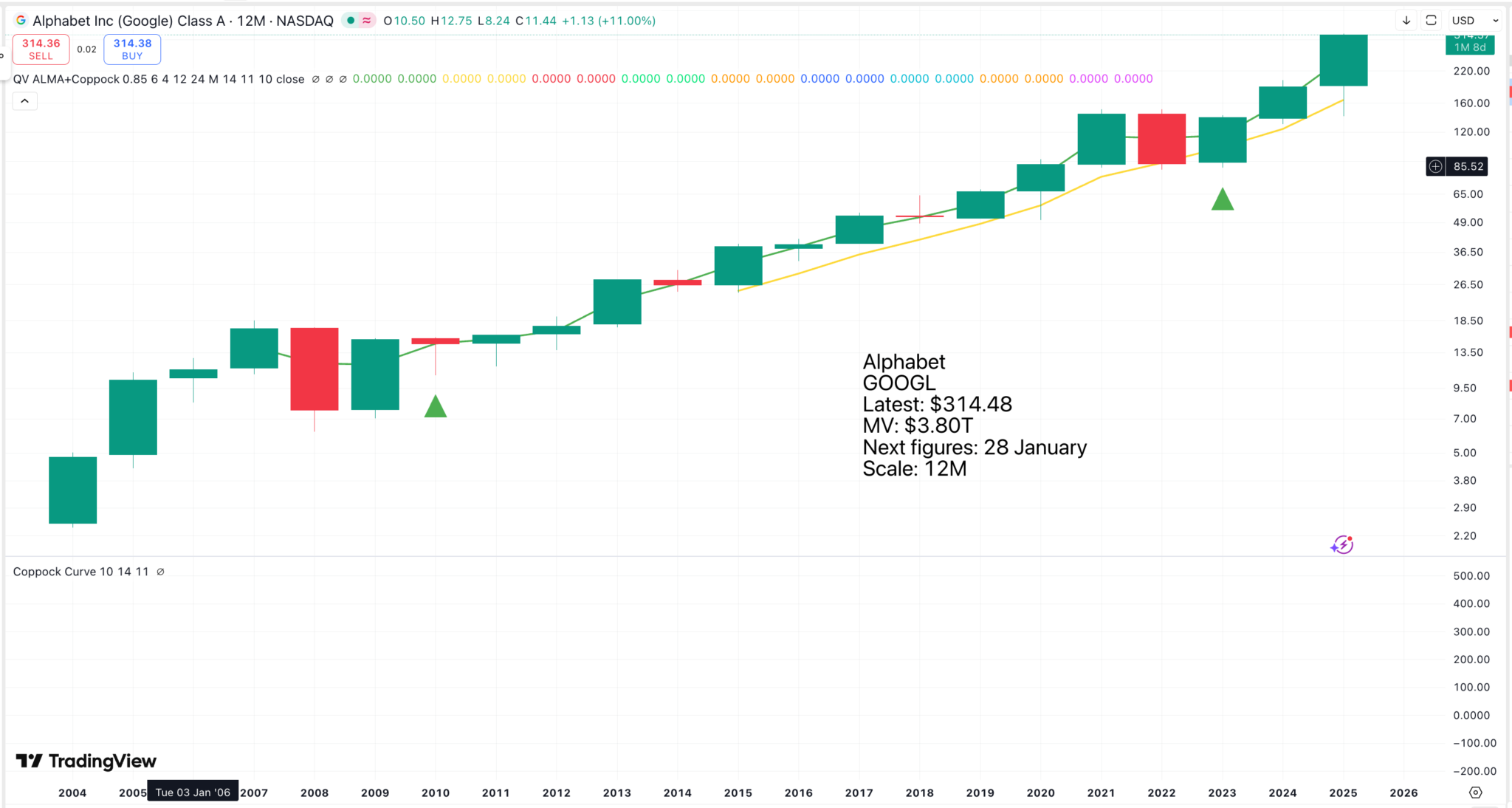
This chart is incredible. If you do not own shares in Alphabet, now is the time to buy some.
Google’s shares are strong due to better-than-expected financial performance, a perceived leadership position in artificial intelligence (AI) innovation, continued dominance in its core search advertising business, and rapid growth in Google Cloud services.
Factors contributing to the stock’s strength are:
Strong Financial Results: Alphabet has exceeded analysts’ expectations for earnings and revenue in recent quarters, with strong growth across all major segments. Its third-quarter 2025 revenue exceeded $100 billion for the first time.
AI Leadership and Integration: The company’s investment in AI infrastructure is yielding results. The launch and adoption of its AI model, Gemini, which powers features like AI Overviews in search, has demonstrated an opportunity for growth.
Resilient Core Business: Google’s search advertising remains dominant and growing. The integration of AI has increased user engagement.
Google Cloud Growth: The cloud computing segment continues to show strong revenue growth and expanding operating margins, with large business backlogs (around $155 billion at the end of Q3 2025). The segment competes with Amazon Web Services and Microsoft Azure.
Favorable Regulatory Developments: A ruling in September 2025 did not require the structural breakup of Google’s core assets, easing investor concerns.
Attractive Valuation and Shareholder Initiatives: Alphabet has been seen as attractively valued compared to other tech stocks, and the company has engaged in shareholder-friendly initiatives, including a stock buyback program and a raised quarterly dividend.
These factors have built investor confidence in Alphabet’s ability to maintain its market leadership.
AI overview
Share Recommendations
Celcuity. CELC
Alphabet GOOGL
I am adding Celcuity to my Top 50 list.
P.S. My team thinks my alerts are too long. Do any subscribers have a view on this? Any feedback would be helpful, and I won’t be offended by criticism.


